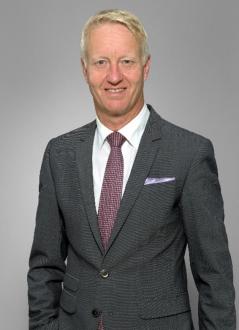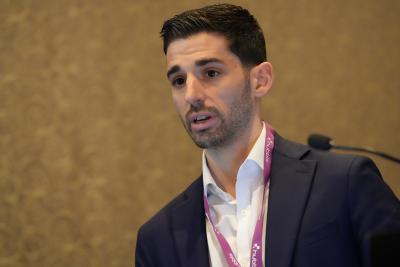Lombard Odier’s Global Head of EAM on Deep Commitment to the Independent Wealth Community

Laurent Pellet of Lombard Odier
Sep 26, 2021
Laurent Pellet is Global Head of EAM for Lombard Odier Group, which has, for many years, made a deep and enduring commitment to the independent wealth management sector across all of the bank’s key markets worldwide. He has been with Lombard Odier since mid-2017, after an impressive multi-decade career with leading private banks, focusing almost exclusively on building their relationships with EAMs. Hubbis ‘met’ with him by video call recently to learn more of the bank’s commitment to the EAM market in Europe, the Middle East, and especially in Asia. We found someone who very clearly still enjoys his mission and has a genuine passion for the clients that the bank serves. And someone who has found a silver lining in the pandemic through a more balanced work-life scenario.
“We are convinced that the EAM sector will grow around the world, as private clients are becoming ever more sophisticated and increasingly seeking and expecting tailor-made products and services, which is not always easy to locate amongst the traditional custodian banks,” Laurent begins. “A key factor is the agility of the EAMs, which help them provide that unique, bespoke offering to clients.”
He observes that the EAM community had, in the not-too-distant past, faced considerable pressures after the 2008 global crisis, and then again in 2011, but that this time around, the regulatory environment is so onerous that the pressures on margins as well mean that the careful consideration of business models is essential.
Clear vision required
“Getting the right strategy in place is therefore not a luxury; it is essential,” he says. “That means defining your markets and your target clients, working out precisely where you can compete and offer real value, and then selecting the right partners and custodian banks to properly serve those clients and deliver the right products and service quality.”
A truly right future ahead
With all these elements in place, Laurent believes that EAMs will have a very bright future. “We are incredibly positive about this sector, but I do caution that the right vision of the future needs to be created or adapted,” he says. “And this vision must be client-driven and tailored precisely to their needs and expectations and their jurisdictions. In short, the EAMs need to think ahead for the next five to 20 years and devise the model that will see them develop, grow and achieve real success, which is certainly out there to be grasped.”
Laurent explains that the bank’s EAM clients comprise the typical mix of what one might term the standard EAM and those positioning themselves as multi-family offices. The difference between both types of EAM clients can be very tight, depending on the respective business model. However, the difference should be in the sense that an EAM offers mainly asset management services including asset allocation, investment, advisory, private placements, while multi-family offices also add services such as estate and tax planning, corporate advisory, family governance, etc.
EAMs - core to Lombard Odier’s DNA
He also offers more insights into the Lombard Odier approach to EAMs in its core markets. “The EAMs we work with value the backing of Lombard Odier and our over two centuries of asset management experience and imagination,” Laurent explains. “That means long-term support from a group that offers a wide range of quality products, services and specialists. We have EAM-dedicated teams in eight offices worldwide, giving the EAMs both global reach and local expertise. And we offer cutting-edge banking technology, so they can focus on what matters most: the clients.”
The best of both worlds
He explains that the EAM clients therefore get the best of both worlds. “They will be patrons of a self-financed, well-capitalised and independently-owned private bank, and they will benefit from high-quality, front-to-back banking services,” he says. “Whilst all the time maintaining a close relationship of trust with their EAMs. And whether the EAM is in Switzerland or another country or region, the bank’s 70-plus dedicated EAM team – based across our eight offices worldwide – is committed to building a genuine long-term partnership with the EAM, founded on trust and excellence.”
He comments that the preservation of client wealth is embedded deep within the bank’s DNA. “Our guiding principle for the past seven generations has been the preservation of client wealth. Today, we look after CHF352 billion of assets for them and have become one of the largest private banks in Switzerland and Europe. Stability is the cornerstone of all we do. We are one of the best-capitalised banks in the world, with more than double the minimum capital required by our regulators, with Basel III Common Equity Tier 1 ratio at 29.1%.”
Traditional but also innovative
But while the bank has traditional roots, Laurent also highlights the strong conviction towards innovation.
“In today’s fast-paced world, we constantly invest in the technology that gives our clients the information they need, securely, when and where they need it,” he explains.
In fact, right from the start of the IT revolution in the 1960s, the bank has been intently focused on being in the vanguard of the ‘Digital Revolution’, he reports. Lombard Odier is keen to highlight this, stating in its literature that it is the only private bank that shares its IT system with other financial institutions, providing services that cover all wealth management requirements.
Technology deeply embedded
On Lombard Odier’s website, the bank reports it is the creator and exponent of its own technological and banking solutions, and that it constantly strives to evolve and anticipate new technologies, always with the aim of better serving clients who are increasingly informed and more demanding.
The bank, in fact, made a landmark decision early on to develop modern portfolio management systems that would make it easier for the clients to control their assets. The first of these systems, which was simply called ‘Gestion’ was used to display and analyse portfolios and place orders online.
In 2002, Gestion was replaced with G2, a dynamic and comprehensive application that offered daily estimates of returns over specified periods of time, forward-looking analyses and attractive visual interfaces. Clients apparently liked the new system so much that the bank decided to equip all of its client rooms with screens. And today, Lombard Odier provides its technology to twelve external banks and more than 300 external asset managers, single and multi-family offices.
In-house development and expertise
Laurent refers to a Lombard Odier report that elaborates on the bank’s Technology & Operations unit, of which, at the core, is the bank’s own IT platform and that the bank will continue to develop that platform in-house.
“For some time, our Managing Partners wondered whether it might be preferable to outsource and move over to a market platform,” Laurent noted, “but they ultimately concluded that it would be better to invest in and modernise the existing platform to maintain this competitive advantage and provide a superior offering to our clients. We consider it to be a competitive advantage – a point of differentiation. We have managed to create a successful platform that enjoys real recognition. According to the feedback from our external asset managers, for example, who are used to working with numerous banks, it is an extremely well-thought-out tool for investment professionals.”
He added that the bank is intent on keeping up the momentum and has named the new phase of the project GX. “This will be a long and extensive process, and one of Lombard Odier’s key investments over the next ten years.”
He notes that the budget is so substantial because the bank needs to meet several objectives simultaneously. “We need to bridge the technology gap. Technologies that the platform leverages need to be refreshed constantly so that our platform remains state-of-the-art. We also need to speed up the digitalisation of our processes, a trend that has gained considerable momentum due to COVID-19. And to round it all off, we have to revamp the client experience - beyond interface design, we also intend to shift our philosophy and be mobile-first. The first consideration for our future developments must be how our clients will access information on their tablet or smartphone. The desktop version comes second.”
Constant innovation
The report also highlighted how, in order to respond to the constantly accelerating pace of innovation, the platform’s architecture must be open and continually updated by integrating new developments and applications developed both in-house and externally, depending on the area of expertise. “On the GX platform, we intend to create numerous application programming interfaces (APIs), which will allow us to integrate several market solutions,” he elucidated. “We need to open up more.”
Tracking key trends
Laurent himself observes that several key trends are increasingly visible amongst the bank’s global EAM clients, and his first highlight is indeed digitalisation. “We see a pressing need for these independent firms to adjust their business models, to review their processes and to become far more efficient, and digitisation can definitely enhance their client services and deliver a more client-centric offering, whilst at the same time automating and improving internal processes and some of the more cumbersome administrative workload,” he reports.
The drive to technological excellence
To achieve that, he advises that they focus on a smart CRM system, an elevated Portfolio Management System (PMS), improved archiving systems and greater automation. “But the solutions available are dependent on the size of these firms,” he says.
“We are certainly seeing a trend for these EAMs to select custodian banks around the world which have an in-depth understanding of their business and can offer multi-booking capabilities, and also, most importantly, state-of-the-art IT systems and connectivity which is the basis for digitisation.”
Laurent points, for example, to the bank’s cutting-edge portfolio management system, which has been developed in-house by bankers for the bank’s professional partners. “G2 Pro allows you not only to analyse your portfolios and their performance, but also to generate personalised and sophisticated reporting for your clients and to consolidate their assets easily, recovering up to 10 years’ worth of historical data,” he commented. “And as you know, the GX project is already underway.”
Consolidating relationships
Another trend is the consolidation by EAMs into fewer custodian bank relationships, and at the same time achieving more streamlined and more efficient connectivity to each of their chosen custodian banks through one system, thereby significantly reducing complexity and boosting efficiency.
He refers to a Swiss-based project named ‘Wecan’, a blockchain technology platform being developed as a collaboration project between banks and EAMs in Switzerland. “The goal is to simplify the whole onboarding compliance duties between banks and EAMs, with all necessary authorisations online and a simplified and streamlined process to the benefit of both the banks and the EAMs.”
The Lombard Odier USP
Laurent reports that with such a keen focus and major investment in its digital platform, this is, without doubt, a key differentiation for the bank. “We offer the global connectivity EAM clients require,” he says, “so for example, the EAM might be in Singapore and working with our booking centres there and in Europe, and they will always operate through exactly the same system. Moreover, our system is different from our competitors.”
“Another key element of our USP, as I clarified earlier, is that we are a true private bank with a track record of over 220 years old. We are not listed, we take a very long-term view of clients and the future, we have a strong balance sheet, a very strong brand and we have proven our solidity over many, many years.”
And he notes that another key differentiation is the bank’s commitment to and expertise in sustainability, and philanthropy. “These are of growing importance to EAMs and their clients,” he explains.
As to the bank’s business in Asia, Laurent comments that despite the hurdles imposed by the global pandemic, they continue to invest in the region, bringing in new talent to exploit the growth potential.
Conservative at the core a key factor
He mused that what might appear as a slight disadvantage but has been seen by clients as a winning strength is the bank’s typically conservative risk appetite. “We are really more conservative than some of the global banks, or even the larger local banks in Asia, especially for lending, but for many of our EAMs this is actually a positive,” he reports. “Accordingly, we focus on those types of EAMs, those who truly value our approach and business model. We are one of the few ‘pure’ private banks today offering dedicated EAM services out of Singapore, and we are doing very well there. And while we don’t offer booking services in Hong Kong, we also manage to achieve good growth there too.”
Connectivity, Asia, are Lombard Odier’s Key Priorities
Laurent’s first priority is to continue to deliver some significant advances in terms of digital solutions, including offering the capability for clients to make mobile payments on the Lombard Odier app. “We started to offer that for Swiss-domiciled clients at the end of June, and we will then extend that across our European markets and the UK, and then across the rest of the world,” he remarked. “Moreover, we will continue to build out our PMS connectivity for EAMs to make things increasingly streamlined and efficient for them.”
Connectivity, he reiterates, is a game-changer. “In the future, most EAMs will want their own PMS, so we want to continue to improve this connectivity and offer the EAMs the possibility of state-of-the-art connectivity between our IT system and their own PMS. That is really the second priority.”
His third priority is more of a personal mission to make sure that all the teams are safe and optimistic. “People are core to our EAM proposition,” he observes. “We have been growing this side of our business rapidly for the past five-plus years, and we are amongst the largest custodian banks for this kind of business, and that is all driven by our talent and commitment. We are totally dedicated to our EAMs, delivering what we feel are amazingly high-quality services to them.”
Finally, Laurent says that he and the bank must continually challenge themselves and reinvent their model for the years ahead. “You will not be surprised to hear that Asia will be front and centre of our global EAM strategy.”
A natural evolution
He closes the discussion by offering his insights into why he believes the EAM market will continue to grow so robustly. “Firstly, the larger EAMs will keep expanding, adding new RMs and also acquiring or partnering with smaller EAMs in the generally fragmented markets in most jurisdictions,” he noted.
Secondly, there is ongoing consolidation in the banking industry, which will often result in RMs leaving due to the changes in management direction and leadership, offering them the opportunity to reconsider their roles and think about going to the independent sector.
“And thirdly,” he explains, “the UHNW and HNW clients themselves are seeking some specific services not on offer at the major banks and preferring the more agile, bespoke and highly individualised approach of the EAMs. All in all, these and other reasons augur well for the EAM sector in the future, not just in Europe but certainly in Asia and in the Middle East.”
Great potential in Asia’s EAM community
He closes the conversation by commenting that the growth of the EAM community in Asia should continue to emulate and possibly outstrip the robust environment for EAMs in Switzerland and in other leading European centres.
“In Asia, we continue to see keen interest amongst senior RMs to venture out to the independent model, especially to the larger EAMs,” he concludes. “I would wager a considerable bet on Singapore driving some very robust EAM growth in the years ahead.”
Getting Personal
Laurent is Swiss and comes from Geneva. After studying Economics at the University of Geneva, his career in private banking soon centred on the EAM community, first for a small private bank then owned by UBS, but which was later acquired by Julius Baer, and then rising through the ranks at Julius Baer, all the time focusing on the EAM community in Switzerland, Europe and the Middle East. He left to join Lombard Odier in 2017.
His career began with Ferrier Lullin, where he held various positions for more than 15 years, including Head of Credit and Risk, and subsequently Head of the External Asset Managers department in 1997. In 2006, he joined Julius Baer to lead their External Asset Managers business for the French-speaking part of Switzerland and Western Europe. In 2012, his responsibilities were extended to cover Monaco and the Middle East.
Laurent holds a Federal Diploma from the Ecole Supérieure de Commerce de Genève. He is a graduate in Credit and Risk Management from the University of Geneva, and in Quantitative Portfolio Management from HEC Geneva. He also holds the ‘International Certificate of Private Banking and Wealth Management Retreat’ from the Swiss Finance Institute, and is a Certified Wealth Management Advisor (CWMA).
He is married with one child of 11 years old, and like many of his Swiss compatriots, he and the family spend a lot of their leisure time in the mountains. “I am still today a qualified Swiss ski instructor. My love of skiing and the mountains remains, of course. Zermatt is our favourite resort.”
With less travel for business these days – normally he would be on the road around 100 days a year, he reports – he says he has really enjoyed spending more time with the family. “The family is my first love, and this has been a great opportunity to really spend quality time with them,” he says. “The hours in my working week are still very long, but I make sure that I really commit my time to the family whenever possible. The pandemic has reinforced all of these passions and loves.

Global Head of External Asset Managers at Lombard Odier






